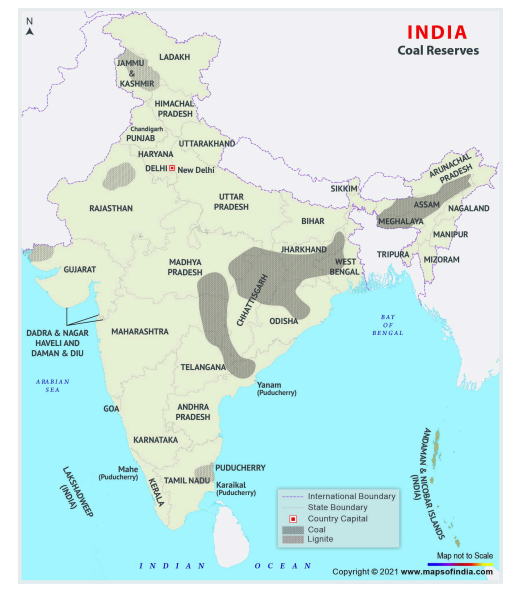
Coal plays a pivotal role in India’s energy sector, serving as a cornerstone for power generation, industrial processes, and household consumption. With abundant reserves distributed across various regions, India stands as one of the world’s top coal producers and consumers. The country’s coal landscape encompasses a diverse array of varieties, including lignite, bituminous, and sub-bituminous coal, each with distinct properties and applications. Understanding the reserves, distribution, and production of these coal varieties is crucial for assessing India’s energy security, environmental sustainability, and economic development trajectory. This discussion delves into the intricacies of India’s coal reserves, their geographical distribution, and the dynamics of coal production, shedding light on the nation’s reliance on this vital fossil fuel resource.
Contents
Answer
Introduction:
The coal sector plays a pivotal role in meeting approximately 55% of India’s energy requirements, making it a crucial component of the country’s energy landscape.
Ranking third globally in both reserves and production, the Indian coal sector encompasses a diverse range of coal varieties, each with unique characteristics and applications.
Body:
Reserves:
- Anthracite: With its high carbon content (above 80%), anthracite serves industrial and metallurgical purposes. However, its reserves are limited, primarily found in the Jammu & Kashmir region.
- Bituminous: This abundant coal type (45% to 80% carbon content) is crucial for power generation, cement production, and as coking coal in the steel industry. Major reserves are located in Jharkhand, Odisha, Chhattisgarh, West Bengal, Madhya Pradesh, Telangana, and Maharashtra.
- Lignite: Known for its brown color and 40-55% carbon content, lignite is utilized for thermal power generation. Key reserves are situated in Tamil Nadu (Neyveli), Rajasthan, Gujarat, and Jammu & Kashmir.
- Peat: At the initial stage of coal formation, peat is not commercially used in India due to its low heating value and high moisture content.

Distribution:
- Gondwana Coalfields: Constituting about 98% of India’s coal reserves, these coalfields are approximately 300 million years old and are mainly found in peninsular regions such as Damodar Valley (Jharkhand and West Bengal), Mahanadi Valley (Odisha), and Godavari Valley (Andhra Pradesh and Telangana).
- Tertiary Coalfields: Aged around 60 million years, these coalfields are located in northeastern states like Assam, Arunachal Pradesh, and Nagaland.

Production:
- India’s coal reserves, distributed across Gondwana and Tertiary formations, are estimated at approximately 319 billion tonnes as of 2020.
- Key coal-producing states include Jharkhand, Odisha, Chhattisgarh, West Bengal, Madhya Pradesh, Telangana, and Maharashtra.
- In the financial year 2019-20, India produced around 729 million tonnes of coal, with Coal India Limited (CIL) contributing nearly 80% to the production.
Conclusion
- In conclusion, India’s coal sector encompasses diverse coal varieties distributed across geologically significant formations, contributing significantly to the country’s energy needs.
In case you still have your doubts, contact us on 9811333901.
For UPSC Prelims Resources, Click here
For Daily Updates and Study Material:
Join our Telegram Channel – Edukemy for IAS
- 1. Learn through Videos – here
- 2. Be Exam Ready by Practicing Daily MCQs – here
- 3. Daily Newsletter – Get all your Current Affairs Covered – here
- 4. Mains Answer Writing Practice – here

